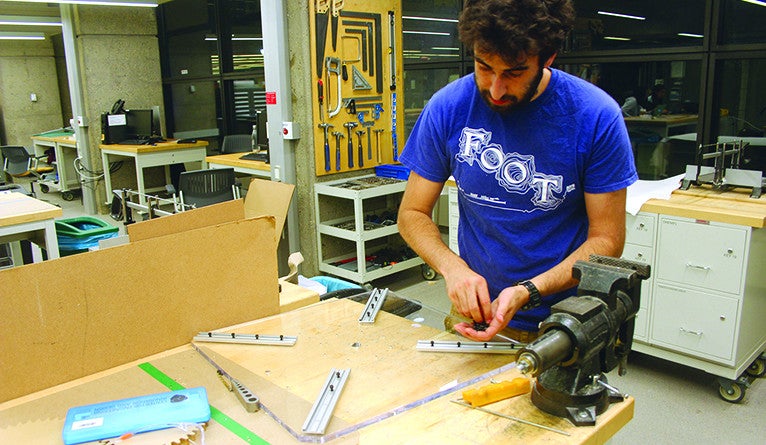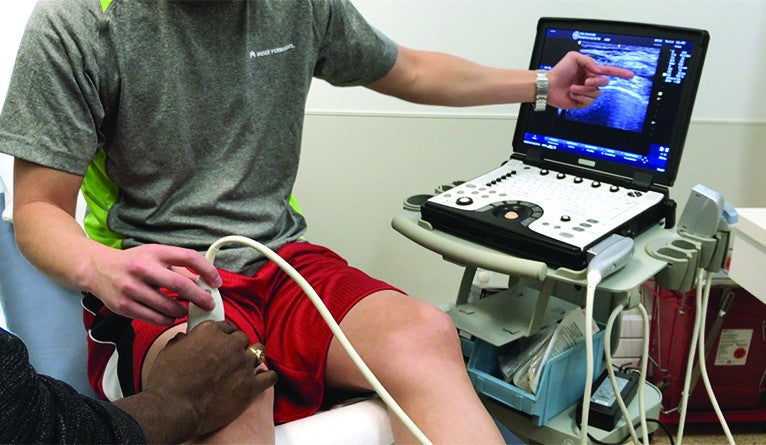Building safer, healthier athletes

This story originally appeared in Yale Engineering magazine.
Since it was first offered, the course Medical Device Design and Innovation has worked with numerous partners, including the Yale School of Medicine, Yale-New Haven Hospital, the VA Connecticut Healthcare System, and the Yale School of Nursing.
This year, for the first time, it’s collaborating with the Yale Athletic Medicine department. Joseph Zinter, who started the class at the Center for Engineering Innovation & Design (CEID) five years ago, said the field of sports medicine sounded like a great fit.
“With all of the clinicians we work with, I try to identify specific challenges that are well-scoped for the course,” said Zinter, assistant director of the CEID. That means projects that can feasibly be completed by the students — juniors and seniors of varying disciplines — in one semester. It also means choosing projects that jibe with the resources and space of the CEID. It’s a formula that has produced patented devices, awards, and student-authored journal publications.
The partnership with sports medicine was sparked by a conversation between Thomas Newman, director of sports performance and innovation for Yale, and Dr. Eliot Hu, Yale’s director of athletic medicine. Newman told Hu about the very productive collaboration he had with Introduction to Engineering Innovation & Design, also at the CEID.
Hu figured it was worth a shot and met up with Zinter. In their conversations, Zinter and Hu homed in on two issues that have long been a concern in sports medicine: concussions and inflamed joints. Awareness about both has increased significantly in recent years, but the medical field is still looking for ways to improve how it addresses each one.
A better concussion recovery
In both the sports and medical worlds, concussions have been given a great deal of attention in recent years. However, diagnosing them and overseeing recovery has remained an inexact science. Working with Hu, students Brian Beitler, Mrinal Kumar, Pong Trairatvorakul, and Holly Zhou teamed up to address that.
The four students developed Ontrack, a system that combines virtual reality with a balance board. How it works: a patient recovering from a concussion balances on the platform of the device wearing a virtual reality (VR) headset. The balance board is equipped with load cells and an accelerometer to measure the patient’s center of gravity. While balancing on the board, the patient wears a virtual reality headset and interacts with a virtual environment. Data collected by the balance board and the VR system is combined with the patient’s subjective observations (such as dizziness or headache) to evaluate the progress of their recovery.

Health experts have long sought a more accurate way to diagnose and treat concussions — and with good reason. Each year, between 1.6 million to 3.8 million sports and recreation-related traumatic brain injuries occur in the U.S., according to the Center for Disease Control and Prevention. Many of these cases go untreated. Symptoms range from mild to severe, including depression and chronic dizziness, nausea, and seizures. Repeated concussions can be even more serious, including permanent cognitive and emotional problems. Concrete data to assess the trajectory of the condition is hard to come by. Measurements of cerebral blood flow can be conducted by fMRI, but it’s costly. Instead, doctors tend to rely on symptoms to monitor recovery.
Hu suggested to the team that they focus on two areas: Ocular (eye movements) and vestibular (balance). “There’s some research that shows that combining the ocular and vestibular aspects will help patients speed up their recovery,” team member Pong Trairatvorakul explained.
“Right now, there’s nothing that really quantifies the symptoms for the balance aspect, so we created an unstable platform that’s able to measure balance,” Trairatvorakul said. “We expect that for a concussed patient, we might see fluctuations in the center of mass.”
With sensors built into the board, users can see the center of mass of the person standing on it, and how well they’re able to maintain their balance.
As for the ocular half of their project, the team created a virtual reality component composed of exercises that track eye movements and measure coordination. In one exercise, the patient tries to catch a virtual ball. It’s based on a real-world exercise that Hu conducts with his own patients.
“Eventually, we want users to play this game on the VR headset, while on the balance board, and then we can combine the two,” Trairatvorakul said.
Hu said the system is where he believes concussion treatment is heading.
“I gave them an incredibly and increasingly difficult project,” he said. “And they came up with something that encompasses everything — and it’s something we’ve never seen before.”
A joint effort
Joint inflammation is a common ailment among athletes, caused by the wear and tear of physical activity. Specifically, synovial fluid builds up in the joints, causing pain. One treatment is to remove the fluid by needle, or aspiration. It’s a common, low risk procedure, but not without some difficulty. For one thing, it’s unwieldy: One of the doctor’s hands must be in contact with an ultrasound probe the whole time, while the other hand endures significant strain performing the injection. The combination of motions makes it difficult to keep a steady hand, which is required for imaging accuracy and keeping the needle stable throughout.

“Often, because of the setup, physicians feel there’s not enough hands,” Hu said. “A lot of people use assistants as their extra set of hands.”
In their report, the students note that there are systems currently available that are designed to correct these issues. However, they tend to be too large to be conducted easily, or in an office setting.
After speaking with Hu, the team of Alyssa Chen, Michael Johnson, Sienna Li, and Allison Skinner set out to develop a system that gives the physician a free hand to stabilize the needle and probe — and does so without taking up too much space. The result was UltraStable, a system that features a large, locking articulating arm with a probe holder connected to its end. It also has a 320-degree needle track above the probe holder that allows for another locking arm to slide around the track and serve as a flexible needle guide system.
As captain of Yale’s women’s softball team, team member Allison Skinner said the project had personal significance for her.
“As athletes, the sheer amount of stress we’re putting on our bodies means we’re often getting injuries, and most of the time these happen to our joints,” she said. Sometimes they can take an inflammatory agent to ease the build-up of fluid in the joint, but sometimes it means having it aspirated with a needle.
Hu thought the student team’s efforts were a significant improvement over the current standard.
“The system they created cuts down on the time that’s needed to do the procedure and gives the ability to lock it in place,” he said. “It’s a big help to the physicians out there who may not have the manpower to help with this procedure. You basically have another hand free to put on a Band-Aid or clean up the area before you inject or aspirate.”
Overall, Zinter said that Hu was a great client for both teams. “One aspect of the class is learning how to interact with a client and communicate across disciplinary lines,” he said. “The students were working very closely with Dr. Hu. It’s a lot of work — visiting the clinic, observing procedures —
and he was there at every step.”
For his part, Hu said the collaboration worked for both sides.
“The students are amazing, and they definitely exceeded my expectations,” Hu said. “I’m glad I had this opportunity to work with them — it was a great experience. I think we learned a lot from each other.”
Related
Media Contact
William Weir: william.weir@yale.edu, 203-432-0105